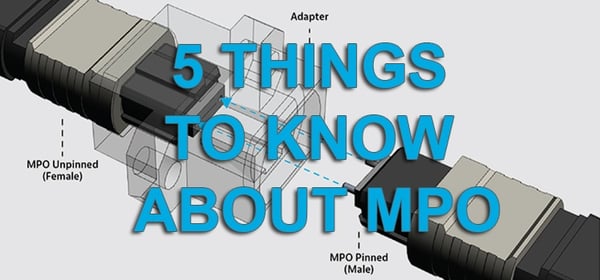 Fiber technicians are constantly challenged to keep up with new, innovative technologies that can disrupt normal long-standing test and certification practices. Whether you are an installation contractor, an IT manager or somewhere in between, understanding the key concepts and practices of any new technology (such as MPO) is critical to keeping pace with industry needs and driving business forward.
Fiber technicians are constantly challenged to keep up with new, innovative technologies that can disrupt normal long-standing test and certification practices. Whether you are an installation contractor, an IT manager or somewhere in between, understanding the key concepts and practices of any new technology (such as MPO) is critical to keeping pace with industry needs and driving business forward.
One of the fastest growing trends in fiber networks is the use of MPO connectivity. In a recent study by VIAVI Solutions of more than 200 people who either design or install networks with MPO connectors, 40% are already doing more than 10 projects per year with MPO connectivity. The growth projections are even higher, with most people expecting their work with MPO to grow by more than 20% in the next three years. If you are a network designer or a field technician, this should be a clear indication that the future of your business will rely significantly on your ability to work with MPO connectivity.
To help you best prepare for this opportunity, here are five key things to get you started on your MPO training.
- Know what MPO connectors are and how they are used in fiber networks. While MPO connectors have been around for many years, they have historically been utilized in places where most technicians don't have to interact with them very much, if at all. This is rapidly changing as network capacity demands increase. As a result, the use of multi-fiber connectivity has become the preferred medium for the latest network architecture designs. They are no longer used only behind the scenes but are now extended all the way to patch panels, switches and servers, where they are front and center for every technician to deal with. To learn more, watch Essentials of Multi-Fiber MPO Testing - Episode 1: Overview of MPO Connectors.
- Know how to properly inspect and clean MPO connectors. As technicians working with fiber connectors know, contaminated connector end faces are the #1 cause for network troubleshooting problems. This problem becomes even greater when working with MPO connectors. With more fibers on the end face, a greater surface area and increased exposure to the fiber behind the bulkhead, the likelihood of contaminated MPO end faces is significantly higher. Essentials of Multi-Fiber MPO Testing - Episode 2: Dealing with Contamination on MPO Connectors explains why MPO connectors are more difficult to keep clean, how this impacts the MPO connections and provides guidance on how to best implement the Inspect Before You Connect process for MPO connectivity.
- Know the Polarity of your MPO connections. Most technicians who have worked with single fiber connectors, such as LC or SC, have probably dealt with polarity to some extent before. With a duplex fiber pair, one connector is used for "transmitting" and the other is "receiving" the signal. With MPO connections, understanding polarity is much more complicated, as there are multiple fibers, multiple traffic patterns and multiple standardized polarity types that a technician needs to understand. Essentials of Multi-Fiber MPO Testing - Episode 3: Understanding MPO Connector Polarity goes into detail about the concept of polarity for traditional duplex fibers and MPO multi-fiber connectors, how the different polarity methods (Type A, Type B, Type C) create confusion in both new construction and network upgrades and how testing for polarity eliminates these problems.
- Know MPO connectors are properly aligned. For technicians that have only worked with LC, SC and other single fiber connectors, connector alignment is something they have likely never thought of before. That is because they haven't had to. Single-fiber connectors have a sleeve inside the bulkhead adapter that aligns the ferrules with precision, ensuring proper core-to-core physical connection. Aligning MPO connectors is much different. Rather than using a sleeve inside the bulkhead, they use a pin and socket approach. One connector has two stainless steel pins on the end face and the other has corresponding sockets. Essentials of Multi-Fiber MPO Testing - Episode 4: Understanding MPO Alignment addresses some of the confusion that technicians face when performing tests and verifying test references in the field. It also highlights some new connector solutions that are helping address these challenges.
- Know what test solutions are available for MPO connections. With all fiber networks, there are essential tests that technicians perform for either certification or troubleshooting purposes, such as: fiber inspection, length and loss testing or advanced OTDR testing to identify specific events throughout the link. While this is no different for MPO connectors, it becomes increasingly complex as the connector interfaces on legacy test instruments have single-fiber connectors. The final episode of the video series, Essentials of Multi-Fiber MPO Testing - Episode 5: MPO Test, highlights various MPO test instruments and explains the value that each one provides to the technician. It also expands on the growing need in Enterprise and Data Center applications to have native testing of MPO links that are directly plugged into the test instruments.
Just like when you start learning a new skill, education and practice are necessities. The same goes for learning to work with new technologies like MPO. Whether you already work with MPO connectivity today and are preparing to face new challenges, or are just getting your feet wet, you can feel confident that VIAVI MPO Experts have your back.


.png?width=58&height=58&name=X_logo_2023_(white).png)
